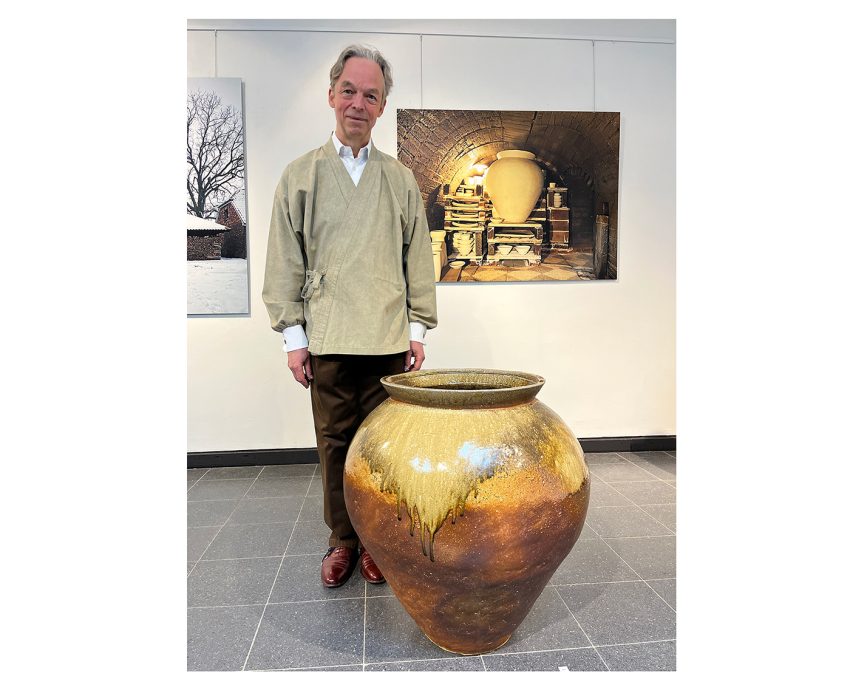
Japan begins in Langerwehe
Jan Kollwitz exhibition in Töpfereimuseum Langerwehe 12 March 2023 – 7 May 2023
. . . . . . . . .
I must admit that until recently, I only had a distant knowledge of the work of Jan Kollwitz, the German ceramicist who has completely embraced traditional Japanese aesthetics. Two years ago, however, I had the opportunity to take a closer look at the work of this rather enigmatic figure, when visiting the pleasant ceramic market in Cologne, held every year in August. There is always a friendly, easy-going atmosphere here and visitors can enjoy interacting with the ceramicists and discuss their work. It was during one of these discussions that I was told that Jan Kollwitz was holding an exhibition right then in the nearby Käthe Kollwitz Museum, which houses work of the famous artist, Käthe Kollwitz, who was Jan Kollwitz’s great-grandmother.
So, after visiting the market, off I went to the museum on the tail of a few of the stand holders, glad to take advantage of this happy coincidence. If first impressions count, then I was immediately struck by the strange juxtaposition between the relaxed colloquialism of the ceramics market and the sober formality of the exhibition setup. Fifty or so individual vessels, ranging from diminutive teacups and bowls to larger vases and lidded containers were set out in a corner vestibule. Each item was positioned to be appreciated in isolation. Most impressive of all were the massive storage jars streaked with trails of fly-ash glaze standing guard at the entrance like Shishi lions waiting to ward off evil spirits. To the rear of the individual exhibits dressed in a Japanese samue jacket, Jan Kollwitz stood humbly bowing to every visitor who entered as a gesture of welcome. On a table was a neat pile of his biographical work, Japan beginnt an der Ostsee.
Now, eighteen months later, another exhibition has been organised, this time in Töpfereimuseum Langerwehe, half way between Aachen and Cologne and a stone’s throw from the massive opencast lignite mines that scar the landscape. The small town of Langerwehe, once a major centre for Rhineland pottery, is famous for its tall storage containers, known locally as baaren. The Töpfereimuseum houses a museum, gallery space, an auditorium and a pottery workshop with a resident potter (Lothar Kurtz). The museum itself has recently been awarded a grant of €250,000 to renovate and refurbish the building and its historical museum collection.
Undoubtedly, a person of such renown as Jan Kollwitz has been quite a catch for this provincial museum. This current exhibition has been two years in the making, which was set in motion through the intervention of local artist and Kollwitz’s acquaintance, Walther Dohmen. To local residents, such an exhibition as this is big news, as was witnessed by the number of visitors at the opening, with extra chairs having to be arranged to accommodate latecomers. They had all come to see the engaging personality of Jan Kollwitz, who addressed the audience with a slideshow in his characteristic samue jacket and pleasant disposition.
Jan Kollwitz has wholeheartedly adopted the Japanese traditions and techniques he originally acquired during a two-year apprenticeship in Japan under the tutelage of Echizen master-craftsman Nakamura Yutaka, before returning home to set up a studio and construct a traditional anagama kiln in the village of Cismar in northern Germany in the late 1980s. Since then he has steadfastly continued to focus his creative output on the rigours and demands of this specific style. Over the years he has settled on a repertoire of no less than 45 forms, ranging from simple incense holders and yunomi teacups to larger formal chawans, mizusashi water containers and hanaire flower vases. In terms of size, his most imposing pieces are his hand-built tsubo jars, which can take up to four weeks to create. He fires his kiln once a year in November when weather conditions are optimal for the effects he wants to achieve. And although this results in a rather modest volume, it enables him to spend time developing innovative subtleties and nuances in form and tone. We are told that he shuns “sensation or superficial effect” and that “he is interested in a gradual improvement in quality, in achieving artistic substance through an unwavering command of craft skills”1. These are of course commendable objectives that probably any number of ceramicists aspire to. There can be little doubt, however, that Jan Kollwitz’s work clearly demonstrates an exceptional understanding of the cultivated sensibilities of traditional Japanese ceramics. It shares those same latent universal qualities and introspective beauty that have long appealed to connoisseurs of wabi-sabi aesthetics and the tea ceremony, but also to a broader audience, including those who can put aside the philosophical overtones and cultural associations and relish the rustic, balanced forms, the rich natural glaze effects of wood-firing and the quiet understatement and sincerity of Japanese ceramics.
Neale Williams
1 Prof. Dr Heinz Spielmann: New Ceramics November/December 2008
. . . . . . . . .
You can read more about Jan Kollwitz, his biography and working practices on his website. The exhibition Japan beginnt an der Ostsee – Keramiken von Jan Kollwitz in the Töpfereimuseum Langerwehe runs until 7 May 2023. Consult their website for full details and other activities organised there.
Töpfereimuseum Langerwehe
Pastoratsweg 1
52379 Langerwehe
Germany
https://www.toepfereimuseum.de
. . . . . . . . .